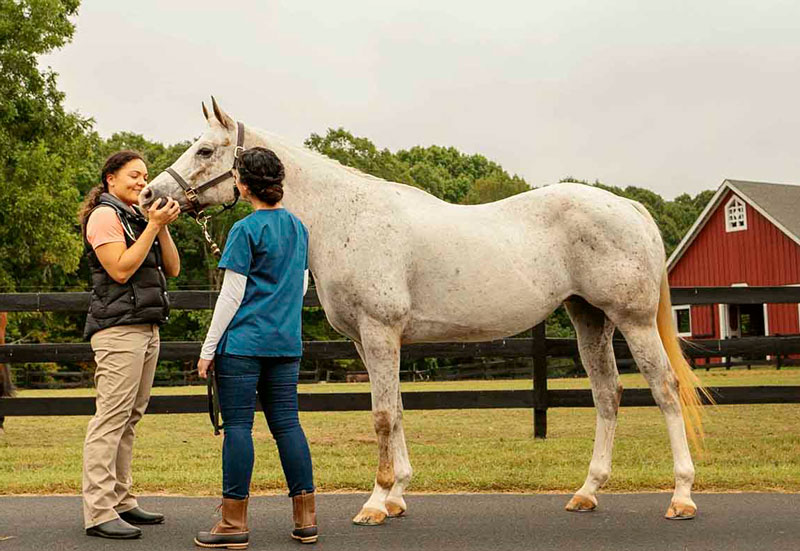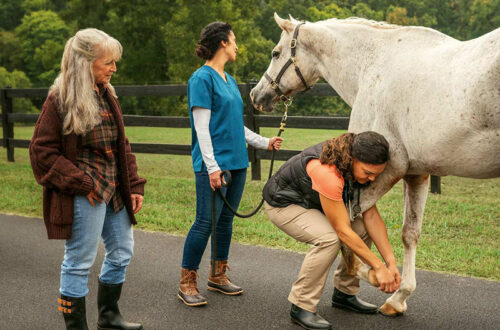
Four Potential Horse Emergencies and How to Respond to Them
By Dr. Jeff Hall, DVM, Senior Equine Technical Services, Zoetis Equine
You love your horse (or pony) more than anything and want to do what’s right to help him live a healthy, happy life. But horses are accident-prone, and not even bubble wrap can prevent all emergencies. Recognizing common medical situations and knowing how to respond to them can help you fast-track your horse’s road to recovery. Here are four common scenarios you may encounter and advice on what actions to take until your veterinarian arrives.
1. Colic
Colic is every horse owner’s worst nightmare because this severe bellyache can require immediate veterinary care or surgery. Colic can be caused by many things, including gas, an impaction (blockage), or a displaced piece of intestine.
What to look for: Signs of discomfort in horses, including pawing, repeatedly lying down and getting back up, biting at their sides, hanging their head low, lack of manure production, loss of appetite, increased respiratory rate (breathing faster), or sweating on the neck or flanks.
How to respond: You know your horse’s every move and can detect even the most subtle change in his behavior. When your intuition tells you something is wrong, call your veterinarian right away to explain what you’re seeing. It is good to get the horse’s vital signs (temperature, pulse, and respiration; see The United States Pony Club Manual of Horsemanship, C Level, pg. 194-198), so that you can give this information to the vet. If you aren’t proficient in taking vitals yet, a more experienced horse person can help you gather this information.
Your veterinarian will offer guidance on next steps, which may include the following advice:
- Remove hay, feed, and sometimes water. Restrict or do not allow grazing until your veterinarian arrives to limit the buildup of feed and fluid in the stomach.
- Keep the horse in a calm environment near a buddy if possible.
- Keep the horse up and calmly walking, if it’s safe to do so.
- Watch out for your own safety! Be sure to choose a space with plenty of room so you stay safe, too.
Also, it’s impotant to know that pregnant mares may be more at-risk for colic the closer they get to foaling and for a few months after the foal is born, so be extra observant of new mamas in your herd and communicate with your veterinarian if there is any possible issue.
2. Wounds or Lacerations
Horses are curious, and they seem to quickly find any and all sharp objects in a stall or pasture. Also, their legs have very little soft-tissue covering for protection, so lower limb wounds can potentially infect a joint or tendon sheath, which could be life-threatening.
Most often, a wound or laceration emergency is due to a protruding object piercing a horse’s sensitive skin or a horse stepping on a sharp object, such as a nail. The edges of a water bucket handle and double-sided clips can also tear eyelids and nostrils. Horses turned out in a herd can also be injured while kicking and playing.
What to look for: An injury with associated swelling and pain when touched as well as severe or non-weight-bearing lameness in one of the legs. In some cases, a scrape, patch of missing hair, or a puncture wound may be the only sign of an injury. In other cases, active bleeding or dried blood may be readily apparent.
- Assess the location and severity of the wound. Sometimes a small puncture wound with minimal bleeding at a joint or a nail sticking out of the bottom of a hoof can be more severe with a worse prognosis than a large flap of bleeding skin hanging off an area like the horse’s chest.
- Superficial head wounds can bleed a lot, but they heal relatively quickly, because there’s a good blood supply to the area.
Contact your veterinarian anytime a wound is bigger than a minor cut or scrape, a wound is located near a joint, or there’s swelling or lameness. What may seem like a minor surface or puncture wound could be more serious. Allowing a small injury to heal on its own may lead to an issue that requires prolonged downtime and additional treatment.
How to respond:
- If your horse is actively bleeding, apply a pressure wrap to stop the flow of blood with a polo or standing wrap.
- If your horse isn’t bleeding, rinse the area with cold water using a hose to remove any visible dirt, gravel, or shavings from the wound site.
- Apply an antiseptic or antibiotic spray or ointment to prevent bacterial infection, wearing clean, disposable gloves. It is recommended to avoid applying antibiotic sprays or ointments without prior veterinary approval.
Always ask for advice before administering medication, because giving the wrong type, dosage, or duration might create secondary side effects. Kids should ask an adult in charge to give any medication to their horse and should not administer it themselves. Finally, if a foreign object (e.g., a nail or piece of wood) is present, keep the horse still and calm, and don’t remove it until your veterinarian arrives as this could result in uncontrolled blood loss or further damage to the horse.
3. Fever
A horse’s normal temperature varies, but an acceptable range is generally between 99.0 -101.5 degrees Fahrenheit. Exercise, especially in excessive heat and humidity, will raise any horse’s temperature, but healthy horses quickly return to normal levels after a period of rest. A prolonged increase in temperature or a reading that’s more than a few degrees above average can suggest an issue.
What to look for: A fever may indicate a localized or systemic infection. When a horse has a fever, he can have an increased respiratory and/or heart rate, go off feed and water, and have patchy areas of sweat over his neck or flanks. Typically, he will also act dull and depressed and may exhibit droopy eyelids or helicopter ears.
How to respond: How your horse feels influences the next steps. For example, if your horse’s temperature is only one or two degrees higher and they’re eating and drinking normally, your veterinarian may not opt for a treatment. Instead, they may recommend taking your horse’s temperature for a few days.
If a fever persists or your horse’s temperature continues to increase, it’s a warning sign. Your veterinarian will want to evaluate your horse to determine the underlying cause in order to decide on a treatment plan.
Get into the habit of checking your horse’s temperature once or twice a month so that you can establish a baseline of what’s normal for him and quickly identify a problem when you notice a behavior change. This also helps your horse get used to having his temperature taken.
4. Injury To or Near the Eyes
The eye is made up of sensitive tissues and can be the site of numerous injuries. This can happen when a horse scratches his face on a fence, from an accidental poke with a piece of hay or tall grass, or while playing with a herd mate. Eyelid lacerations or corneal ulcers are some of the most common eye injuries and are always considered an emergency.
What to look for: Excessive tearing or swelling of the eyelid is a telltale sign. A horse may likely also squint or hold his eye shut. When looking at your horse head-on, the eyelashes of both eyes should point in the same direction, about 45 degrees downward. If the eyelashes point downward more on one side, that’s the side that’s injured.
How to respond: Any injury to the eye is considered an emergency, and you should call your veterinarian right away. Prevent the horse from rubbing his face on his leg, stall wall, or a handler until your veterinarian arrives to assess the situation. You may need to put a clean fly mask on the horse to help protect the area.
Always ask for advice before administering medication, because giving the wrong type, dosage, or duration might create secondary side effects. Kids should ask an adult in charge to give any medication to their horse and should not administer it themselves.
Plan Ahead
Chances are you have a first-aid kit for your family. Since your horses are your family too, having a kit for the barn or stable is an important part of proactive planning and responsible horse ownership. When you have the necessary supplies and knowledge of common emergencies, you can respond faster and increase your horse’s chances of a full recovery. These are the basic supplies we recommend having on hand to respond to emergencies:
- Thermometer
- Lubricant for the thermometer, such as petroleum jelly
- Stethoscope
- Latex or nitrile disposable gloves
- 4″ x 4″ gauze pads
- Leg bandages with appropriate padding and vet wrap
- Elastic tape
- A mild, standing sedative for use in certain stressful, non-painful situations or husbandry procedures, such as bandage changes or clipping
- Bandage scissors
- Duct tape
For more on creating your equine first-aid kit, please see the 2022 Safety Handbook published by the United States Pony Clubs.
Simple wounds can develop severe complications if left untreated or treated inappropriately. Ensuring that your veterinarian administers your horse’s annual core disease vaccinations can help prevent severe life-threatening diseases, such as tetanus, which lives in the soil. If an injury occurs more than six months after the last tetanus vaccine, a booster is recommended, according to vaccination guidelines published by the American Association of Equine Practitioners.1
Visit zoetisequine.com to learn more.
References
1. American Association of Equine Practitioners. Infectious disease control vaccination guidelines. https://aaep.org/guidelines/vaccination-guidelines/infectious-disease-control. Accessed September 1, 2022.

About Zoetis— Official USPC Equine Health and Wellness Partner
To learn more about how Zoetis is making lives better for horses and those who care for them, visit zoetisequine.com and Zoetis Equine on Facebook and Instagram.





